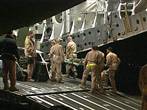It's not often you have the opportunity to witness the work of these Medical Warriors: the Docs at the CSHs and in Balad, and the Heroes of the Flight Line and the Critical Care Aeromedical Team. So be sure to watch.

Feb. 27: One of the keys to the success of military medicine is quickly getting wounded personnel into fully equipped hospitals. NBC's Robert Bazell reports on how that's accomplished in Iraq. - Nightly News
Watch the video
The accompanying article is informative and worth a read, too.
For the seriously wounded the goal is not necessarily to fix the problem, but to keep the patient alive and stabilize him or her long enough to get to the next stop on the journey home.
For example, doctors, nurses and medics in Iraq worry far less about infection than they would at a hospital in the U.S., although the staff works to keep everything as clean as possible. The wounds themselves are often the filthy aftermath of bomb explosions. In addition, Iraq’s ever-present dust is always blowing, sometimes even into the operating room. When infections occur it is usually three or four days after an injury. By that time, the patient is thousands of miles away.
It is the same with treatments involving surgical repair of bones and internal organs.
“Often you can’t fix everything at once,” says Dr. Darryl Pugh, an Army surgeon in Baghdad from Ft. Belvoir, Va. “Sometimes we do a little bit here, then the guys down the road in Landsthul and Walter Reed do the rest. It’s a very different kid of medicine.” ...
After they are stabilized at the outlying CSH’s, the patients travel by helicopter to the hospital at Balad where they are re-checked and treated further, if needed. From Balad they take the C-17 flight to Germany and then onto the U.S. ...
Medivac helicopters make dozens of runs a day from the field and between hospitals. C-17s take off almost every night. Everyone knows that, at any moment, bad weather, mechanical problems with the aircraft or a surge in casualties can cause a backup, leaving some very sick troops unable to be moved. When that happens, one doctor told me, “We have to make some very tough decisions.”
Usually the operation runs smoothly, resulting in a survival rate of 96 percent among those who make it to the first hospital — the best in U.S. military history.

Raw video shot by NBC News on a C-17 flight from Balad Air Base in Iraq to the U.S. military hospital in Landstuhl, Germany.
Watch the video
I may update this later, but wanted to get it posted during lunch...
Update: So my lunchtime blogging sucks. This was actually the second part of this 5-part series.
Here's the first video about the Medical Warriors of the CSHs, Saving lives in field hospitals.

No comments:
Post a Comment